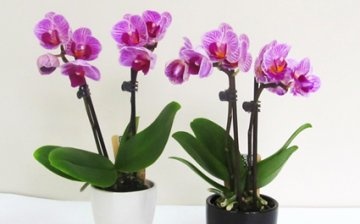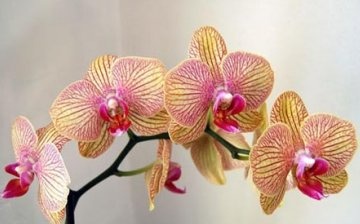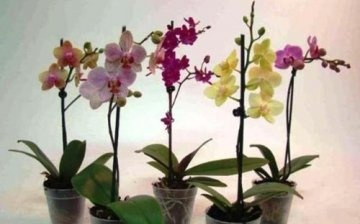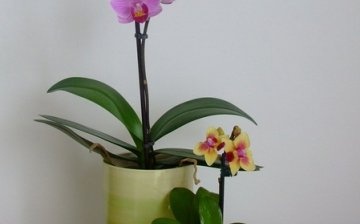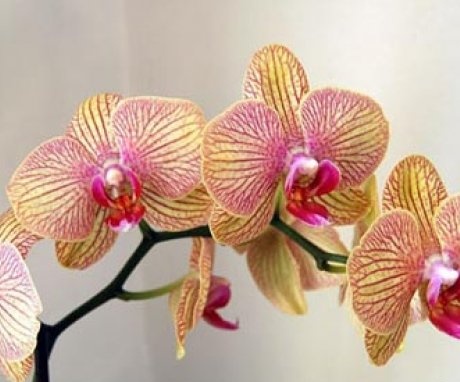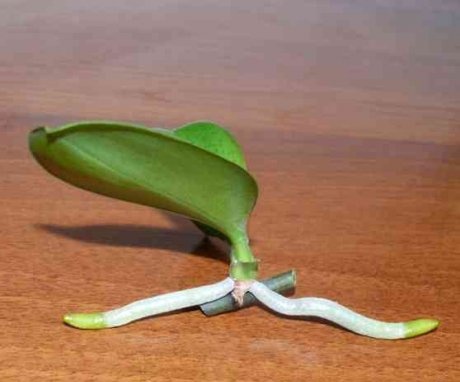Phalaenopsis mix: types, reproduction and home care
Phalaenopsis is an unpretentious type of orchid. And by observing some rules of caring for them, you can enjoy the flowering of the plant for many years.
Content:
- General information about Phalaenopsis mix
- Phalaenopsis species
- Plant care
- Reproduction of phalaenopsis
- Phalaenopsis diseases and pests
General information about Phalaenopsis mix
Phalaenopsis is one of species of the orchid family... It is a perennial plant. Its leaves are green, fleshy, oblong and obtuse. They emerge from the root rosette and grow in two rows. Peduncles emerge one at a time from each leaf sinus. Thus, on one plant 2-3 branches with bunches of magnificent flowers can bloom at the same time.
The shape and color of the petals in phalaenopsis is varied and depends on the variety. Also, some varieties of flowers emit a pleasant aroma. Its homeland is tropical forests, where the humidity is constantly high, and the air temperature at night is not lower than +20 degrees.
Despite the fact that in most cases, phalaenopsis requires special care, its popularity is growing.
This is due to the fact that the flowering time is long, and the beauty of the flowers fascinates many. These plants are often used in offices, beauty salons and spa areas. The fashion for these beautiful plants came to Europe from Japan. Locals have long fallen in love with orchids and used them to decorate their homes and offices.
Phalaenopsis species
Popular types of phalaenopsis:
- Phalaenopsis is beautiful. It is a medium sized variety. The leaves are wide, they grow up to 20 cm in length. Several heavy buds are located at the same time on a 30 cm peduncle. The flower petals are painted white with burgundy purple stains.
- Phalaenopsis Schiller. Large variety, blooms profusely, unpretentious. The leaves are wide, large, grow up to 45 cm. Painted in a dark green tone with silvery spots, randomly located throughout the leaf area. From the bottom, the color is violet-brown. The peduncle can stretch up to 1 meter in height. On it are densely arranged buds, the petals of which are painted in a delicate crimson tone. The flower can be up to 9 cm in diameter. The flowering period lasts several months from mid-winter to mid-spring.
- Phalaenopsis pink. This is a miniature orchid variety. The leaves are wide, dark green in color, grow only 15 cm in length. On a brown peduncle, which usually does not exceed 20 cm in height, there are 12-15 buds. The petals are pale pink with bright streaks. Due to its low growth, this Phalaenopsis variety looks very impressive when flowering.
- Phalaenopsis is giant. This variety is one of the largest. Its leaves can be up to 40 cm wide and 1 meter long. They are painted green, shiny, leathery, hanging. On a 40 cm peduncle, there can be up to 30 buds. The petals are fleshy, colored in a light cream or greenish-yellow tone with bright reddish spots. The flower is 7 cm in diameter, its shape is rounded. A pleasant citrus aroma emanates during flowering.
- Phalaenopsis Luddemann. It is a medium sized variety. The leaves are wide, painted in a light green tone, have an oval shape and stretch up to 25 cm in length.Peduncles are low, each has up to 7 small buds. The petals are painted in a pink-purple tone, which becomes brighter towards the middle of the flower. The diameter of one flower is 5 cm.
- Phalaenopsis is pleasant. Medium sized variety. Leaves are wide, can reach 50 cm in length. They are painted in dark green color. Oval, fleshy, leathery. The peduncle is up to 70 cm high. One branch can have up to 20 buds. Flowers in diameter can reach 10 cm, they unfold sequentially. The petals are always white, the lip can be yellow or red.
- Phalaenopsis is hieroglyphic. Medium sized variety. The leaves are colored green, shiny, wide, up to 30 cm in length. On a low peduncle, up to 30 cm, there are several buds that open almost simultaneously. And the flowering period lasts about 1 month. Cream colored petals with lemon yellow pattern.
- Phalaenopsis Parisha. This is one of the miniature varieties. The leaves, painted in dark green color, reach only 17 cm in length. On a low peduncle there are up to 10 buds. The petals are cream or milky, the lip can be purple or dark purple. Its middle part is almost the same size as the petals, which gives the flower a special beauty. The buds open at the same time and continue to bloom for 3 weeks.
Plant care
Phalaenopsis care is unusual. For a good and abundant flowering to him it is necessary to maintain conditionssimilar to the rainforest. Also, during planting, not ordinary soil is poured into the pot, but a specially prepared substrate. Many nuances distinguish the care of this plant, but this has not weakened its popularity.
The plant does not die at a temperature of -10 or +40 degrees, but this does not mean that there is no need to maintain the regime.
In summer, the air around the plant should be warmed up from +20 to +25 degrees. In winter, you can slightly lower the bar to +18. With this mode, the plant will bloom regularly and profusely. Drafts should also be avoided, phalaenopsis can get sick if they stand near an open window.
Watering the plant:
- A large flower is watered once a week, but if the room has high humidity, then watering can be reduced to 10 days.
- Small plants are watered a little more often. But you need to constantly alternate watering and drying the substrate.
There are also several ways to water:
- You can water the plant in a pot or in a tray. Phalaenopsis breeders do not welcome such watering, but according to the experience of flower growers, it is no worse than others. It is especially suitable for the flowering period, which can last for several weeks in orchids. During this period, it is not recommended to move the pot from place to place.
- Also, transferring the pot to a container with water can serve as watering. The substrate and roots are independently saturated with moisture. For this, the container is filled 2-3 cm with warm soft water.
- Phalaenopsis love warm showers, which are very similar to tropical rain. The flower pots are transferred to the bath, set securely so that they do not overturn. They are sprayed with soft, warm water on top for a long time.
- Watering with running water from the shower is not recommended. High chlorine content can damage the plant. After such a "house rain", you need to wait 20-30 minutes until the excess water comes out of the pots and then transfer them to their places. With such watering, it is also necessary to ensure that water does not remain in the rosettes of the leaves. This can lead to decay.
Phalaenopsis needs good bright lighting during its growth period. But you should not expose it to direct sunlight, as burns may appear on the leaves. It is best to find a bright spot with shade. During the flowering period, Phalaenopsis does not need sunlight at all, so it can be transferred to any part of the house and enjoy its beauty. The only condition is daily spraying.
Also, orchids always lean towards the sun, so periodically the pot must be turned. Otherwise, the plant will tilt to one side and constantly turn the pot over.
Flower feeding:
- In nature, orchid nutrients are obtained from the bark of the trees on which they grow.
- At home, the process goes the same way, so phalaenopsis can bloom profusely and often without feeding. But after a while, the substrate will also become empty. Therefore, you still have to feed the plant. To do this, you need to purchase special fertilizers developed for orchid flowers.
- It is necessary to feed the plant between flowering. A diseased or affected plant cannot be fertilized, this can lead to its death.
High humidity is a prerequisite for good growth and flowering of phalaenopsis. It is recommended to install an artificial humidifier near these plants or place pots near a moisture source. If the first 2 points are missing, then each plant must be sprinkled daily with soft warm water. During the flowering period, water should not come into contact with the flowers.
Reproduction of phalaenopsis
Phalaenopsis reproduces at home by lateral shoots, which may appear on a peduncle or near a leaf outlet. For an amateur florist, this is a holiday. But don't rush separate a young shoot from the mother plant. It is necessary to wait until it has 2-3 of its own roots. After that, the little phalaenopsis can be transplanted into your own pot.
This requires:
- Purchase a transparent pot and a special substrate for orchids, which consists mainly of moss and tree bark.
- It is recommended to fill such soil with boiling water for 1-2 minutes for disinfection.
- After the substrate has cooled, it must be poured into the pot.
- We carefully place the small orchid in the upper part of the substrate.
- After that, it is necessary to create a good temperature and humidity regime for the plant.
Phalaenopsis is transplanted in almost the same way. The main thing is to carefully remove the adult plant from the pot and free all the roots from the old substrate. To do this, you must first water the flower. The pot is selected one size larger than the previous one.
Phalaenopsis diseases and pests
Mostly phalaenopsis diseases associated with improper care. With an excess of moisture in combination with low temperatures for a flower suppuration may appear... If you find this, you must immediately remove the plant from the pot, remove all rotten parts and transplant it into a new pot with fresh substrate. Move it to a warmer place and reduce watering.
In a hot season, with a lack of moisture, dry spots may appear on the edges of the leaves. To avoid this, summer spraying should be carried out more often, or the plant should be removed to a cooler place.
Phalaenopsis are also susceptible to attack by the scabbard. This happens especially often if the plant dries up. At a young age, this insect is almost invisible. But after a while, spots appear on the leaves. Large insects sit under shields, from under which larvae crawl out and spread throughout the leaf and to neighboring plants.
To destroy them, it is necessary to regularly spray the phalaenopsis with soapy water, and remove the insects from the plant with a damp cotton swab. The treatment process can be delayed, so be patient. The larvae of this insect can hide in sockets and after a while crawl out again.
Aphids can also attack phalaenopsis. It feeds on leaf juices and settles on its lower side.
Therefore, when watering, it is worthwhile to regularly view all the flowers on the presence of pests... There are many drugs for aphids that can be purchased at specialized stores. When processing a plant, the soil must be covered with polyethylene so that chemicals do not get on it.A day after treatment, the plant is washed out. If it reappears, the process must be repeated.
More information can be found in the video.



